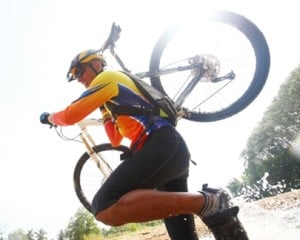Are You A Triple Threat?

For many, completing a triathlon is the ultimate symbol of overall fitness. Competitors race by land and sea (or other body of water) to challenge themselves with the endurance test that inspired the Ironman competition. In case you’re wondering, the “Olympic” triathlon is a 1.5 km (.93 mile) swim, 40 km (25 mile) bike race and 10 km (6.2 mile) run. Ironman takes it to the extreme with a 3.8 km (2.4 mile) swim, 180 km (110 mile) bike race and a full marathon (42.2 km/26.2 mile) foot race to the finish. There are other variations of the race that are shorter or longer than the Olympic distance triathlon, but the Ironman is the longest triathlon.
To train for a triathlon, you have to include weight training and flexibility training in addition to building your swimming, cycling and running stamina. All those workouts leading up to the day of the event will torch calories and help you achieve your best form.
Start your triathlon training
The best time to begin training for a triathlon is 16-20 weeks before the event. You can adjust this time frame based on your starting fitness level. If you’re already an athlete experienced in the three sports of which the triathlon is comprised, you can choose a more accelerated time table. If you are completely new to fitness training of any sort, it would be best to give yourself six months to a year to build up your endurance and avoid injury from taking on too much too soon. Whatever your fitness level, a triathlon is a great way to test your mettle.
Where to go to train
Biking, swimming and running are great outdoor activities. Thanks to the convenience of municipal aquatic centers and public parks, it’s easy to find a free place, or at the very least less expensive than a private gym, to train any time of year. However, when it comes to the extreme cold of winter or heat of summer, you may want to move your training indoors. If a gym membership isn’t your thing, you can always invest in home equipment.
- Swim – An Olympic-sized pool may not be the most economical piece of home gym equipment, but if you’re really determined to swim at home, Endless Pools start at $6,900. Compared to a membership at your local YMCA or YWCA, the price still seems a little steep. You should also consider the cost to power your Endless Pool and the increase in your water and electricity bills.
- Bike ride – You can always go with a stationary exercise bike to practice your cycling in the comfort of your own home. However, there are some energy-related drawbacks here, too. If you get one of those fancy bikes that electronically tracks data or adjusts resistance, you can bet on rising electricity bills. Try a stationary bike stand instead. You can use the equipment you already have (your trusty road bike) and get the added bonus of training with your race-day bike.
- Treadmill – Like a stationary bike, a treadmill helps you train to run at home. Also like the stationary bike, you may see a small spike in your electricity bill if your treadmill is anything other than 100 percent manual. If you are looking for a green splurge, check out treadmills that actually generate electricity and use your own energy to help keep the lights on!




